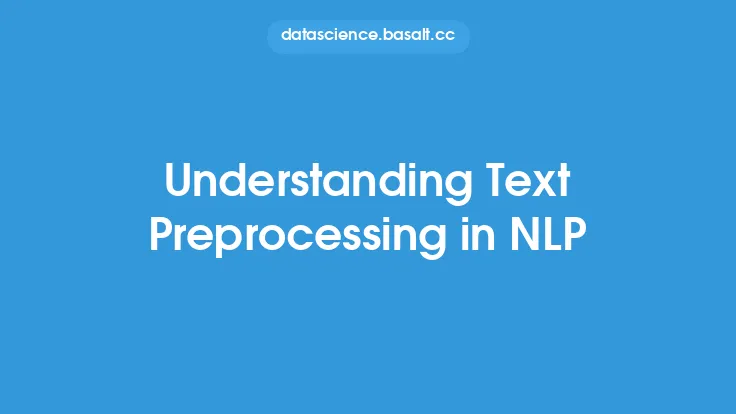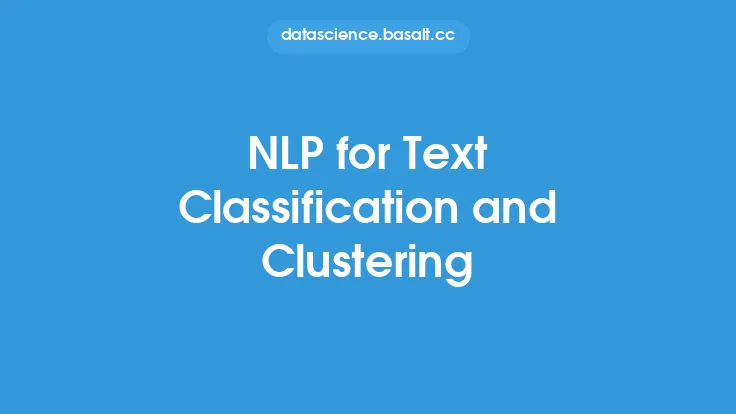Natural Language Processing (NLP) is a subfield of machine learning that deals with the interaction between computers and humans in natural language. It involves a range of techniques and tools to process, analyze, and generate human language data. One of the fundamental steps in NLP is text preprocessing, which involves cleaning and normalizing the text data to prepare it for analysis. Two important techniques used in text preprocessing are tokenization and stopwords removal.
Introduction to Tokenization
Tokenization is the process of breaking down text into individual words or tokens. It is a crucial step in NLP as it allows us to analyze and process the text data at the word level. Tokenization can be performed using various techniques, including rule-based approaches, machine learning-based approaches, and hybrid approaches. The choice of tokenization technique depends on the specific application and the characteristics of the text data. For example, in English, tokenization can be performed using simple rules such as splitting the text into words based on spaces and punctuation. However, in languages such as Chinese and Japanese, tokenization is more complex due to the absence of spaces between words.
Types of Tokenization
There are several types of tokenization, including word-level tokenization, subword-level tokenization, and character-level tokenization. Word-level tokenization involves breaking down the text into individual words, while subword-level tokenization involves breaking down the words into subwords or word pieces. Character-level tokenization involves breaking down the text into individual characters. Each type of tokenization has its own advantages and disadvantages, and the choice of tokenization type depends on the specific application and the characteristics of the text data.
Introduction to Stopwords
Stopwords are common words that do not carry much meaning in a sentence, such as "the", "and", "a", etc. These words are usually ignored in NLP applications as they do not provide much value to the analysis. Stopwords can be removed from the text data using a stopwords list, which is a predefined list of common words that are ignored in the analysis. The stopwords list can be customized based on the specific application and the characteristics of the text data.
Types of Stopwords
There are several types of stopwords, including functional stopwords, lexical stopwords, and semantic stopwords. Functional stopwords are words that have a grammatical function, such as "the", "and", etc. Lexical stopwords are words that have a lexical meaning, such as "run", "jump", etc. Semantic stopwords are words that have a semantic meaning, such as "happy", "sad", etc. Each type of stopwords has its own characteristics, and the choice of stopwords type depends on the specific application and the characteristics of the text data.
Tokenization and Stopwords in NLP Applications
Tokenization and stopwords removal are used in a range of NLP applications, including text classification, sentiment analysis, topic modeling, and language modeling. In text classification, tokenization and stopwords removal are used to preprocess the text data before training a machine learning model. In sentiment analysis, tokenization and stopwords removal are used to extract the sentiment-bearing words from the text data. In topic modeling, tokenization and stopwords removal are used to extract the topic-related words from the text data. In language modeling, tokenization and stopwords removal are used to train a language model that can generate coherent and natural-sounding text.
Challenges and Limitations
Tokenization and stopwords removal are not without challenges and limitations. One of the major challenges is the handling of out-of-vocabulary (OOV) words, which are words that are not seen during training. OOV words can be handled using techniques such as subword modeling or character-level modeling. Another challenge is the handling of domain-specific terminology, which can be handled using techniques such as domain adaptation or transfer learning. The choice of tokenization technique and stopwords list can also have a significant impact on the performance of the NLP application.
Best Practices
To get the most out of tokenization and stopwords removal, it is essential to follow best practices. One of the best practices is to use a high-quality tokenization technique that can handle the characteristics of the text data. Another best practice is to use a customized stopwords list that is tailored to the specific application and the characteristics of the text data. It is also essential to evaluate the performance of the NLP application using a range of metrics, including accuracy, precision, recall, and F1-score.
Future Directions
The field of NLP is rapidly evolving, and there are several future directions for tokenization and stopwords removal. One of the future directions is the use of deep learning techniques, such as recurrent neural networks (RNNs) and transformers, for tokenization and stopwords removal. Another future direction is the use of multimodal techniques, such as vision-language models, for tokenization and stopwords removal. The use of transfer learning and domain adaptation techniques can also be explored for tokenization and stopwords removal.
Conclusion
Tokenization and stopwords removal are fundamental techniques in NLP that are used to preprocess and normalize text data. The choice of tokenization technique and stopwords list depends on the specific application and the characteristics of the text data. While there are challenges and limitations to tokenization and stopwords removal, following best practices and using high-quality techniques can help to get the most out of these techniques. As the field of NLP continues to evolve, we can expect to see new and innovative techniques for tokenization and stopwords removal that can handle the complexities of human language.





